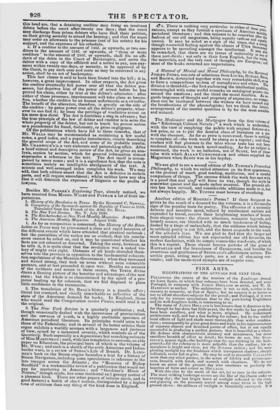FINE ARTS.
ILLUSTRATIONS OF THE ANNUALS FOR NEXT YEAR.
FOLLOWING the course of the tourists of the Landicope Annual, we leave Spain, to which four volumes have been devoted, and enter Portugal, in company with JAMES HOLLAND as artist, and IV. Elamusosi as author. The architecture is not so rich, neither is the scenery so romantic, as that of Spain ; but no country is so barren as not to afford abundant subjects for the pencil ; and Portugal, if it were only for its various associations dear to the port-loving Englishman and its well.foughten fields, is interesting to us. The name of JAMES Hor.LAsm is less known than it deserves to be; for though he has done but little as yet, the few works he has produced have been excellent, and what is more, original. He understands architecture well, and has a tine feeling for colour ; but he has studied local effects of light and shade more thoroughly than wider combine. tions ; consequently he gives great force and truth to his representations of separate objects and detached points of effect, but is not equally successful in producing a perfect picture, that is beautiful as a whole. He defines with characteristic accuracy and minuteness, but never sacrifices breadth of effect to detail ; his forms do not, like STAN- FIELD'S, appear rigid—the buildings near the eye sticking to the !Jack- ground—for the substance is more palpable than the outline; his at- mosphere is bright and clear, yet the distance retires ; and his most glowing sunlight has the freshness which transparent shadows, sharply indicated, never fail to give, lie may be said to resemble CANALETTI more than any other painter, in the union of fidelity and picturesque- ness, breadth with finish, and warmth with clearness. We do not know an artist of the present day who combines so perfectly the beauties of form and colour as HOLLAND. With this clue to the merit of the art, let us turn to the sub;eets. The most striking landscape scenes are the Bar of the Douro under an evening sky; the last bright burst of sunlight reflected in the river,
and glancing on the peasants seated among some ruins in the high ground above : the stillness of twilight is beautifully conveyed. It'
red by AJOITTAGE. The view of Oporto from St. John's, is,
ego the grandest : the river, winding between
ja point of composition,
Ire
cliffs, broken into bold headlands, one of them crested OP r"-f e which 's again visible on the strand below, gives a ro- :12 ., beauty to the scene. The near view of Oporto, from the river, .th the city, which I nti ewhat still and formal—warm in light but cold in effect. Two 01 'I gra' • er scenes, Villa Nova and Coimbra, are bright and clear, and ma ;rlividiful; the shallow stream in the view of Coimbra, fringed '7 oh wi° 'll ws and bestrode by a long curved bridge and floating a barge a its surface, reminds us of the Thames. It is beautifully engraved GOODALL. The view most characteristic of the sunny clime, isithe. peep at the many-arched aqueduct from the vine, trellis of a semi- , ‘ nay ith the gouvernante fallen asleep in the shade while telling her iess‘. J. CODsEN is the engraver. Of the architectural and street scenes, the Tower of the Clergy, rto shooting up in marble whiteness above the adjacent houses, ot ped in the blaze of noon, with the umbrellas and canvas shelters of 0:et-market-people scattered around (engraved by J. STEDHENSON)— sa the Old Cathedral, Coimbra, its huge Norman portal thronged by kneeling peasants, and a fruit-woman in her broad-flapped hat sitting in the shade—have the most national character. The Gothic church of St. Francesco, Oporto, (engraved by W. WALLTS,) is admirable for the neat, sharp definition both of the near and distant buildings. In the Rua Mezericordia, Leiria— a cal de sac, occupied by groups of
i
buyers and sellers, with the vyed turrets of the fortress overtopping the buildings—the minuteness is rather pkite and Dutch : but the cir- cular chapel of the Convent of the Serra, Oporto, stands out in bold relief; its white walls reflecting the sunlight, and the foreground objects in shade being indicated with the matter-of. fact strength of STANFIELD. This plate owes much to the engraver, JAMES B. ALLEN: the union
i of massing and detail s perfect.
We have reserved to the last two exterior and two interior views of the famous Batalha, a royal monastery erected in honour of the battle of Aljubarrota, in the year l385, after the designs of an English archi- tect, STEPHEN STEPITENsoN. In this edifice the Gothic and Moorish styles are intimately blended ; the most redundantly florid ornaments of the Tudor age are here seen in conjunction with pointed and horse- shoe arches and ogee canopies. The effect is sumptuous and fantastic rather than grand and nob. le—the magnificence is overlaid by decoration : the side view of the edifice, with the stream in the foreground, is an exquisite miniature landscape' and the plate, engraved by WILLmORE, is marvellous for the union of high and minute finish with broad pic- torial effect. The engravings are, with scarcely an exception, beautiful specimens of art ; but we. are obliged to be content with naming the engravers of the most strikingly effective plates. It would be tedious and unprofitable to enter into a minute review of their excellences and defects; and, moreover, hardly fair, without the original drawings to compare them with : these we have not yet had an opportunity of seeing.



























 Previous page
Previous page